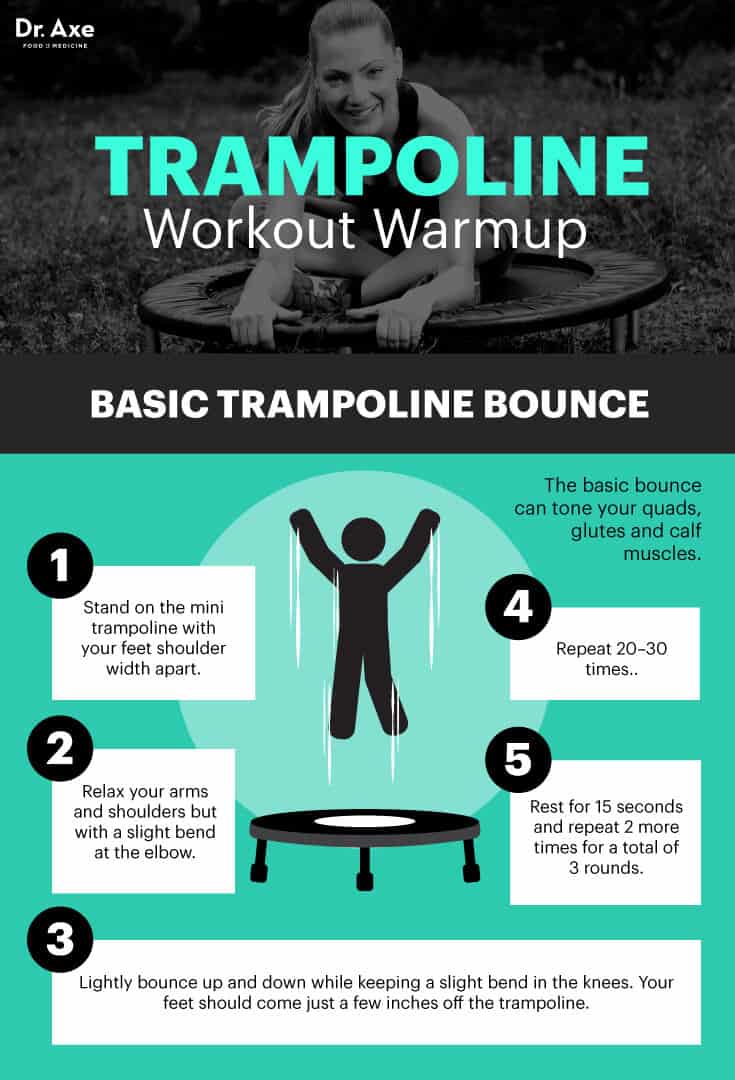The Benefits of a Trampoline Workout and Rebounding (Part One)
Many people first fall in love with trampolines as children, but did you know that a trampoline workout can benefit adults just as much as they bring joy to the little ones?
It’s true. In addition to being fun, a trampoline workout, also known as rebounding, has many great health benefits — particularly for your lymphatic system.
For instance, did you know that rebounding can burn more calories than walking or jogging? Or that it’s a great way to work your major muscle groups because it allows you to work them through their full ranges of motion? Or that it’s downright fun?!
A trampoline workout can also strengthen your body while detoxifying the cells within it. Plus, it’s a low-impact exercise option that’s very easy on the joints — something running can’t match.
While you may think the type of large trampolines you seen in backyards may be a bit much, there are small versions that can fit right in your living room and are easy to store. So get ready to jump around and improve your health all at the same time. Read on to learn how to do a trampoline workout, and how exactly it strengthens the body.
Background & History of Rebounding
Trampoline and tumbling exercises have been around for a very long time and can be traced to archeological drawings found in ancient China, Egypt and Persia. (1) The firs modern trampolines were developed in 1934 by George Nissen and Larry Griswold at the University of Iowa, according to the official website of the Olympic movement.
Trampolines were originally used to train astronauts and were used as a training tool for other sports, such as acrobatics, tumbling, diving, gymnastics and freestyle skiing. Eventually, trampolines became so popular to the point of becoming a sport in the Olympic games. (2)
The first Trampoline World Championships took place in 1964, and trampoline was first recognized as a sport in the U.S. in 1967. The double mini-trampoline competition was added in 1978 and began as two individual mini-trampolines, separated by a small table covered by a mat. Later, a one-piece unit was developed by Bob Bollinger and is used today as the official equipment for that event.
Trampolines have become useful in the understanding of gravity and its effects on exercise. The Journal of Applied Physiology recorded a study by NASA in 1980 on rebounding by testing eight young males ages 19–26. The goal was to understand body acceleration distribution and its relation to how it was created.
The results indicated that, for similar levels of heart rate and oxygen intake,
the magnitude of the biomechanical stimuli is greater with jumping on a trampoline than with running, a finding that might help identify acceleration parameters needed for the design of remedial procedures to avert deconditioning in persons exposed to weightlessness. (3)
Trampoline Workout Benefits
We all know the benefits of exercise, but what are the benefits of rebounding, specifically? Let’s explore.
1. Easy on the Joints
Working out on the trampoline, or rebounding, has way less impact on the joints, soft tissue and skeleton. Due to how a trampoline is made, most often using either springs or bungee bands, it absorbs much of the impact at every bounce.
The NASA study previously mentioned notes that there seems to be more balance of pressure or force, known as G-force, when on the trampoline. Pressure is more evenly distributed at the ankle, back and forehead when rebounding, whereas when running, the pressure is mostly all placed on the ankles, often causing more frequent injury.
That means simply switching to a trampoline workout routine can naturally reduce joint pain and help you avoid common running injuries.
2. Strengthens Cells and Improves Cardiovascular Development
A trampoline workout can provide impressive aerobic exercise benefits by strengthening the heart. When tested, the work required to perform trampoline exercise at equivalent levels of effort was significantly greater while on the trampoline than while running.
When oxygen reaches our cells, it helps strengthen them and provide the ability to endure more exercise efficiently, and because the body is able to increase oxygen uptake when rebounding, versus some other physical activities, it’s possible to get a much better workout.
Rebounding can increase oxygen uptake because more oxygen can reach the cells due to the gravity changes that occur when bouncing. In some studies, when testing on the treadmill, the ability to uptake more oxygen was greater when on the trampoline. This could allow participants to perform exercise for longer periods of time.
A study regarding the effects of daily short bouts of trampoline exercise during eight weeks on the pulmonary function and the maximal oxygen uptake of children with cystic fibrosis was reported by the International Journal of Sports Medicine. Six girls and two boys with cystic fibrosis, 10–13.5 years of age, participated in a prescribed exercise program on a mini trampoline. The training consisted of three short rounds of trampoline exercise.
The study showed that their maximal oxygen uptake (VO2 max) improved during the exercise period. In addition, trampoline exercise programs are suggested to supply other types of training to avoid monotony in the training for many patients. (4)

3. Improves Immune System Function Due to Lymph Flow
Rebounding can lead to increased lymph fluid circulation, which helps boost the immune system by providing a greater white blood cell activity. The lymphatic system is part of your circulatory system and transports a clear, colorless fluid, called lymph, that flushes toxins from your body. It’s believed that there is an increase in the circulation of this fluid when the lymphatic valves are opened during a change in gravitational pull.
This particular change occurs upon the moment you land on the trampoline, thanks to gravity. Then, upon leaving the surface, the lymphatic valves are opened. The increased G-force g that occurs when you land causes a surge of lymphatic drainage, which improves circulation and, therefore, may help detoxify your entire system. (5)
4. Helps with Balance
Another study reported by the U.S. National Library of Medicine cited the effects of different types of exercise on postural balance in elderly women. These exercises can help prevent functional limitations due to aging, therefore reducing the risk of falls.
This study aimed to evaluate the effects of three different exercises: mini-trampoline, aquatic gymnastics and general floor gymnastics. Seventy-four physically independent elderly women were randomly assigned to three intervention groups. Each group performed physical training, including cardiorespiratory, muscular strength and endurance, flexibility, and sensory-motor exercises for 12 weeks. To determine the effects on each intervention group, postural balance tasks were performed.
The study concluded that there were significant improvements in the postural balance of elderly women after 12 weeks of training and ultimately provides further evidence that exercise, like a trampoline workout, that includes balance postures can promote health in elderly women. (6)
5. Builds Physical Strength, Muscular Development and Proprioception for Athletes
Rebounding is often said to improve physical strength and muscular development as well as proprioception, which is the ability to sense the position, location, orientation and movement of the body and its parts.
Cornell Hospital for Special Surgery cited a study in which five healthy subjects had their proprioception measured by doing a single-leg stand with eyes closed before and after two months of training for 20 minutes, three times per week, using rebounding. The results showed that the time that the subjects could stand on a single leg increased by several seconds. This is most important to athletes to help prevent injuries — as well as decreasing the falls in the elderly, which can lead to complicated issues such as hip fractures. (7)








